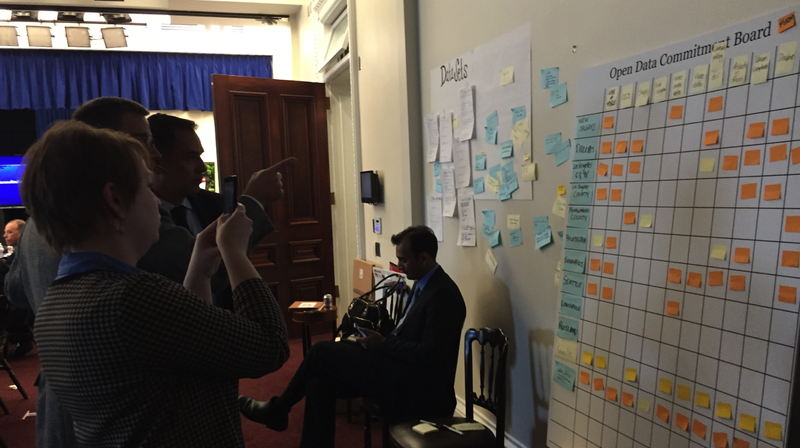OpenGov Voices: Challenges and solutions to collecting law enforcement data

On May 18, 2015 the White House formally launched the Police Data Initiative (of which the Sunlight Foundation is a participant!) with a speech by President Obama in Camden, N.J. However, before the formal launch, many of the initial partnerships began to form at an April 8 convening at the White House. As part of that gathering, individuals participated in four topic-specific breakout sessions to identify challenges and solutions across areas critical to law enforcement data collection, analysis and release. The following summaries outline key challenges and solutions identified during group discussions.
Data supply chains
During this session, participants debated the life cycle of data, from collection to storage and retention to decisions about release. Discussion centered on the importance of metadata in both the collection and publishing phases, as well the need for better collaboration with vendors in developing tools that are responsive to the needs of law enforcement agencies. Many attendees felt that current systems were cumbersome, and not entirely designed with the end users in mind.
What were some solutions to these issues? The need for better procurement procedures was identified, along with an incremental approach to modernizing IT systems. A central point of conversation was the need to adopt technologies that reduce barriers to officers collecting data in the field, with a suggestion that departments insist on collaborative relationships with vendors in the design of software products for them. With regard to the release of data to the public, it was suggested that departments use existing municipal infrastructure to make that process easier. For example, many large cities already support a municipal open data portal that could host datasets released by departments.

Balancing privacy and access
Many privacy issues arise when we discuss opening up incident-level data to the public, in terms of both officers and citizens, especially when dealing with juveniles and victims. During this session, participants discussed how to share data in a way that respects these issues. The key issue arising during this breakout was the lack of guidance around what legally can and cannot be shared by departments. While variance around privacy law across states can complicate matters, participants agreed that the development of a best practices guide related to privacy issues, including a risk assessment document and model policy, would be beneficial in helping departments move past privacy-related issues when attempting to share data with the public.
In instances when redaction might be needed before the release of certain datasets, several agencies cited the high cost of department personnel time as a barrier. Many in attendance indicated a desire for a lightweight text redaction solution that would not be burdensome on staff time.
Data as dialogue
The publication of previously undisclosed data about policing, and the associated increase in transparency, presents a unique opportunity to consider how data might be used as a starting point for conversations between law enforcement agencies and the communities they serve. In this session, participants discussed how appropriate context could be provided alongside dataset releases, as well as how to effectively incorporate public feedback into the policies and processes represented through the data. In particular, with respect to feedback loops for the community, several departments suggested the use of constituent satisfaction surveys and officer score cards.
Other ideas for giving context to the data that would aide community dialogue included developing partnerships with local university researchers and other data and technology groups to help interpret the data and develop products, including reports, dashboards, maps and other visualizations. However, in addition to the development of data products, many noted the need for departments to be more transparent around policies, trainings and department goals, which would make it easier for the community to contextualize the data and connect policy to outcomes.
Data analysis
This session dove deeper into the discussion of data analysis. In particular, participants wanted to understand how innovations in data science might be incorporated in police departments to support internal accountability. Here, many challenges related to the earlier data supply chain discussion, which included the difficulty of aggregating data across multiple systems as well as “data input fatigue” affecting the quality and amount of data that is entered into department systems, which in turn affects the quality of any analysis. Another recurring theme from earlier discussions dealt with the lack of the capacity internally to conduct rigorous evaluation that might lead to important insights about departments.
Again, participants addressed the opportunity to partner with university researchers, with a note that in smaller jurisdictions it may be useful to collaborate across departments when engaging researchers and data analysts. Others stressed the need for automated tools, particularly for smaller departments, which would enable more efficient analysis and understanding of internal data for departments of all sizes.
It was recognized that while not every department can invest in the same level of internal data analysis, it is critical that pathways are created to share lessons learned across departments, particularly as departments better understand what indicators are most important when evaluating how they practice policing.
Building a community around open data and policing
As more law enforcement agencies around the country consider how they can increase transparency and drive meaningful community engagement through the release of data about policing, the community around the Police Data Initiative is committed to enabling that work by helping provide solutions to the inevitable challenges along the way.
To learn more about the Police Data Initiative, read this blog post by U.S. Chief Technology Officer Megan Smith and Deputy Assistant to the President for Urban Affairs Roy Austin.
Interested in writing a guest blog for Sunlight? Email us at guestblog@sunlightfoundation.com

